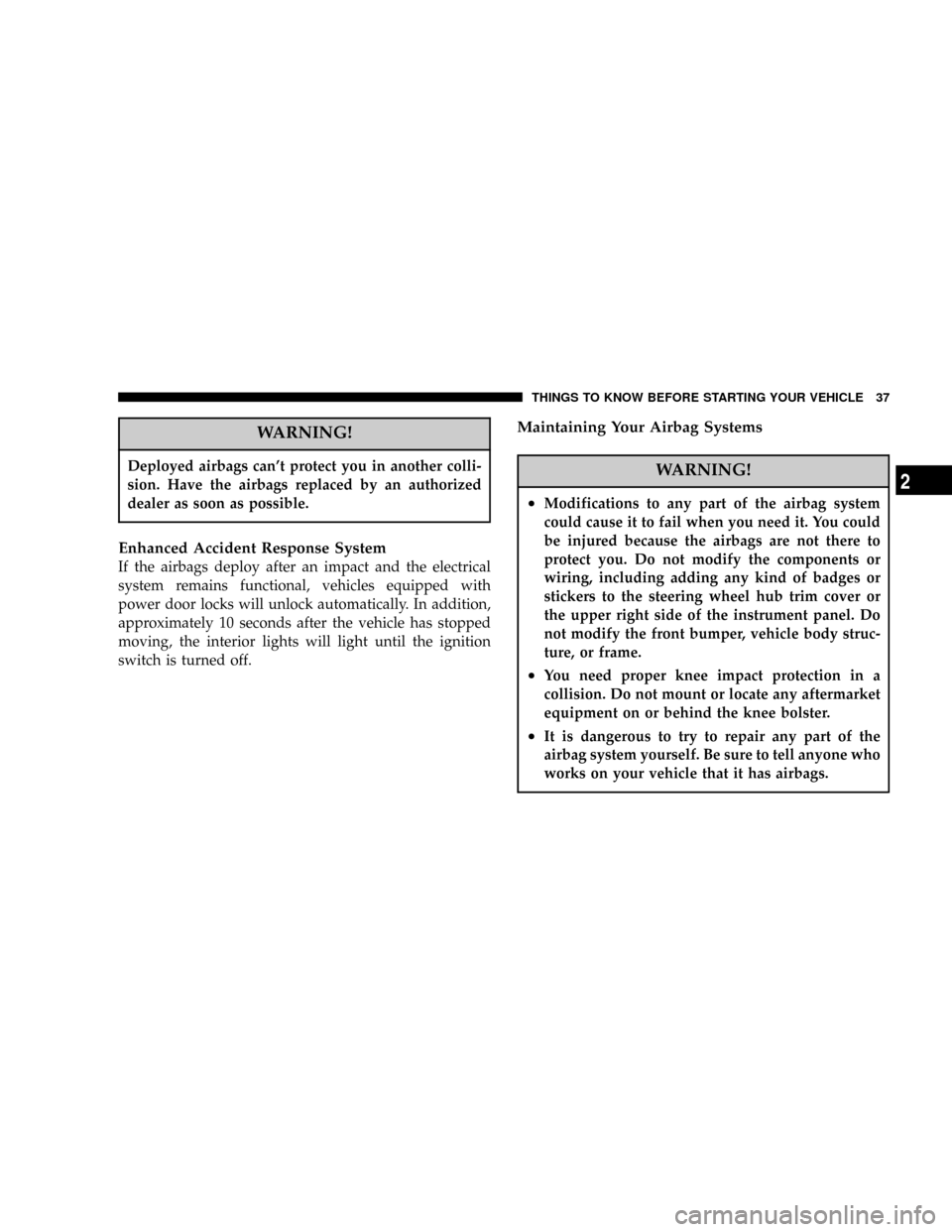2004 DODGE DAKOTA wiring
[x] Cancel search: wiringPage 33 of 300

²The driver and front passenger seats should be moved
back as far as practical to allow the airbag room to
inflate.
WARNING!
²Relying on the airbags alone could lead to more
severe injuries in a collision. The airbags work
with your seat belt to restrain you properly. In
some collisions the airbags won't deploy at all.
Always wear your seat belts even though you
have airbags.
²Being too close to the steering wheel or instru-
ment panel during airbag deployment could cause
serious injury. Airbags need room to inflate. Sit
back, comfortably extending your arms to reach
the steering wheel or instrument panel.
Airbag System Components
The airbag system consists of the following:
²Airbag Control Module
²AIRBAG Readiness Light
²Driver Airbag
²Passenger Airbag
²Steering Wheel and Column
²Instrument Panel
²Airbag Control Module bullet (with integrated crash
sensor)
²Interconnecting Wiring
²Knee Impact Bolsters
²Passenger Side Frontal Airbag ON/OFF Switch
How The Airbag System Works
²
The airbag control module determines if a frontal
collision is severe enough to require the airbags to
inflate.
²The airbag control module will not detect side, roll
over, or rear collisions.
THINGS TO KNOW BEFORE STARTING YOUR VEHICLE 33
2
Page 37 of 300

WARNING!
Deployed airbags can't protect you in another colli-
sion. Have the airbags replaced by an authorized
dealer as soon as possible.
Enhanced Accident Response System
If the airbags deploy after an impact and the electrical
system remains functional, vehicles equipped with
power door locks will unlock automatically. In addition,
approximately 10 seconds after the vehicle has stopped
moving, the interior lights will light until the ignition
switch is turned off.
Maintaining Your Airbag Systems
WARNING!
²Modifications to any part of the airbag system
could cause it to fail when you need it. You could
be injured because the airbags are not there to
protect you. Do not modify the components or
wiring, including adding any kind of badges or
stickers to the steering wheel hub trim cover or
the upper right side of the instrument panel. Do
not modify the front bumper, vehicle body struc-
ture, or frame.
²You need proper knee impact protection in a
collision. Do not mount or locate any aftermarket
equipment on or behind the knee bolster.
²It is dangerous to try to repair any part of the
airbag system yourself. Be sure to tell anyone who
works on your vehicle that it has airbags.
THINGS TO KNOW BEFORE STARTING YOUR VEHICLE 37
2
Page 143 of 300

mLoading Wide Building Materials..........194
mTrailer Towing........................195
NDefinitions..........................195
NTrailer And Tongue Weight..............197
NTrailer TowingÐHitches................198
NTrailer Towing Information
(Maximum Trailer Weight Ratings).........199
NTrailer Towing Requirements.............199
NTrailer Tow Wiring....................200NCooling System TipsÐTrailer Towing.......201mSnowplow...........................201
NDodge Dakota Models..................201
mRecreational Towing (Behind Motorhome, Etc.)
Of 4X4 Vehicles
.......................202
NRecreational Towing Procedure............202
NReturning To Normal Operation...........204
mTraction.............................206
mEquipment Identification Plate............206
STARTING AND OPERATING 143
5
Page 197 of 300

Wheel9style trailer, this range of loading on the9King
Pin9should be between 15% and 25%.) Loads balanced
over the wheels or biased toward9heavier in the rear9
can cause the trailer to sway severely side to side
which will cause loss of control of vehicle and trailer.
Failure to load trailers heavier in front is the cause of
many trailer accidents.
²Donotinterconnect the hydraulic brake system of
your vehicle with that of the trailer. This could cause
inadequate braking and possible personal injury.
²Trailer brakes are recommended for trailers over 1,000
lbs. (454 kg) and required for trailers in excess of 2,000
lbs. (907 kg).
²Use an approved trailer harness and connector. If a
hitch is ordered, the proper wiring will be provided.
²When hauling cargo or towing a trailer, do not over-
load your vehicle or trailer. Overloading can cause a
loss of control, poor performance or damage to brakes,
axle, engine, transmission, steering, suspension, chas-
sis structure or tires.
²Make certain that the load is secured in the trailer and
will not shift during travel. When trailering cargo that
cannot be fully secured, dynamic load shifts can occur
that may be difficult for the driver to control.
²All trailer hitches should be professionally installed on
your vehicle.
²Safety chains must always be used between your
vehicle and trailer.
²Connect trailer lighting and brakes using factory har-
nesses only. Do not cut or splice any wiring to the
brake circuits.
Trailer and Tongue Weight
Gross Trailer Weight (GTW) means the weight of the
trailer plus the weight of all cargo and equipment loaded
on the trailer when in actual underway towing condition.
The recommended way to measure GTW is to put your
fully loaded trailer on a vehicle scale. The entire weight
of the trailer must be supported by the scale.
Tongue Weight is the weight placed on the vehicle's
trailer hitch by the trailer. Always load a trailer with 60%
STARTING AND OPERATING 197
5
Page 198 of 300

to 65% of the weight in the front of the trailer. This places
10% to 15% of the GTW on the tow hitch of your vehicle.
Trailer sway control and equalizing hitch are required for
tongue weights above 350 lbs. (159 kg).
Trailer TowingÐHitches:
With a Class I Hitch, your vehicle can be equipped to tow
trailers with a Gross Trailer Weight (GTW) of 2,000 lbs.
(907 kg) maximum. Vehicles equipped with a rear step
bumper are rated for a Class I Hitch.With a Class II Hitch, your vehicle can be equipped to
tow trailers with a Gross Trailer Weight (GTW) of 3,500
lbs. (1,587 kg) maximum. Tongue weight must be equal to
at least 10% of GTW, but no more that 15% of GTW.
With a Class III Hitch, your vehicle can be equipped to
tow trailers with a Gross Trailer Weight (GTW) of 5,000
lbs. (2,268 kg) maximum. Tongue weight must be equal to
at least 10% of GTW, but no more that 15% of GTW.
With a Class IV Hitch, you can tow a trailer with a Gross
Trailer Weight of up to 6,700 lbs. (3039 kg.) depending on
your vehicle equipment. The Trailer Tow Package in-
cludes the platform hitch receiver, and a 7 lead wiring
harness mounted on the hitch.
NOTE:When towing a trailer, the following require-
ments must be adhered to:
²GCWR must not be exceeded
²Total weight must be distributed between the tow
vehicle and the trailer such that the following four
(4) ratings are not exceeded:
1.GVWR
198 STARTING AND OPERATING
Page 199 of 300
![DODGE DAKOTA 2004 3.G Owners Manual 2.GTW
3.Tongue weight rating for the trailer hitch uti-
lized (This requirement may limit the ability to
always achieve the 10% to 15% range of tongue
weight [15% to 25% for a(5th Wheel(style trailer] DODGE DAKOTA 2004 3.G Owners Manual 2.GTW
3.Tongue weight rating for the trailer hitch uti-
lized (This requirement may limit the ability to
always achieve the 10% to 15% range of tongue
weight [15% to 25% for a(5th Wheel(style trailer]](/manual-img/12/5586/w960_5586-198.png)
2.GTW
3.Tongue weight rating for the trailer hitch uti-
lized (This requirement may limit the ability to
always achieve the 10% to 15% range of tongue
weight [15% to 25% for a(5th Wheel(style trailer]
as a percentage of total trailer weight.)
4.GAWR ratings
NOTE:
Towing a trailer equipped with more than the
standard lighting (turn, tail, stop and backup lights) may
cause an abnormally high electrical current draw through
the headlight switch, causing the switch to fail. To
prevent a recurring switch failure install a trailer tow
wiring harness overlay kit with relay to bypass headlight
switch (available from your dealer).
Trailer Towing Information (Maximum Trailer
Weight Ratings)
(Trailer Towing Guide(
NOTE:
For trailer towing information (maximum
trailer weight ratings) refer to the following website
address:http:// www.dodge.com/towing.
In Canada, refer to the following website address:
http:// www.dodge.ca.
Trailer Towing Requirements
All Dodge Dakota trucks are intended to tow trailers up
to 2,000 lbs. without added equipment or alterations to
standard equipment. Your vehicle may be factory
equipped for safe towing of trailers weighing over 2,000
lbs. with the Trailer Tow Package. The electrical part of
this package includes an instruction sheet, a 7/4 pin
adaptor, a wiring pigtail for an aftermarket electric trailer
brake controller, and three relays that must be installed
into the power distribution center. These items are stored
in the glove box. Also included in the Trailer Tow
Package are two fuses and a relay that are located on the
driver's side of the engine compartment on a harness
near the Power Distribution Center. This relay and the
fuses power up the trailer towing option. See your Dodge
dealer for further information.
If you regularly pull a trailer, regardless of the trailer size,
stop and turn signals on the trailer are recommended for
motoring safety. To handle the additional electrical load
STARTING AND OPERATING 199
5
Page 200 of 300

of the trailer lights and assure their proper functioning, a
heavy duty turn signal flasher can be installed as a
separate equipment item by your dealer.
WARNING!
The direct connection of hydraulic brake lines from
vehicle brake system to trailer system is not accept-
able. The extra load may cause brake failure and you
may be injured.
Heavy trailer towing also may require breakaway electric
trailer brakes, anti-sway devices or equalizing hitches for
safe operation. Such devices are commonly required by
state law.
For all trailer tow or heavy-duty applications it is
strongly recommended that the factory fill rear axle
lubricant be replaced with an SAE 75W-140 synthetic
gear lubricant. MopartSynthetic Gear Lubricant is of
this type.
Trailer Tow Wiring
The Trailer Tow Package includes a wiring harness
located at the rear underbody of the vehicle.
NOTE:Connect trailer lighting and brakes using fac-
tory harnesses only. Do not cut or splice wiring to the
brake circuits.
The electrical connections are all complete to the vehicle
but you must mate the harness to a trailer connector.
Refer to the following table for wire color and function.
Wire Color Function
Black Ground Wire
Blue Trailer Brake
Black/Orange Tail & Running Lamps
Red/Tan Battery
Dk. Green/Red Lt. Stop & Turn Signal
Brown/Red Rt. Stop & Turn Signal
Violet/Black Backup Lamps
200 STARTING AND OPERATING
Page 299 of 300

Tires ..............................54,175
Air Pressure......................... 175
Alignment.......................... 181
Chains............................. 182
Changing........................... 209
Compact Spare....................... 178
General Information................... 175
High Speed......................... 177
Inflation Pressures.................... 176
Jacking............................. 211
Load Capacity....................... 172
Radial............................. 178
Replacement......................... 180
Rotation.........................183,264
Safety...........................167,175
Sizes............................... 169
Snow Tires.......................... 183
Spare Tire........................... 210
Spinning............................ 179
Tread Wear Indicators.................. 180
Warnings........................... 182
Wheel Nut Torque.................... 213
Tongue Weight/Trailer Weight............. 197Torque Converter Clutch................. 149
Towing
Disabled Vehicle...................... 217
Guide.............................. 199
Recreational......................... 202
Trailering........................... 195
Weight............................. 199
Traction.............................. 206
Trailer Towing......................... 195
Cooling System Tips................... 201
Hitches............................. 198
Minimum Requirements................ 199
Trailer and Tongue Weight.............. 197
Wiring............................. 200
Trailer Towing Guide.................... 199
Trailer Weight......................... 199
Transfer Case.......................... 248
Fluid.............................. 260
Transmission....................146,150,245
Automatic.....................144,146,245
Filter.............................. 247
Fluid........................245,247,260
Manual.......................144,150,245
INDEX 299
10